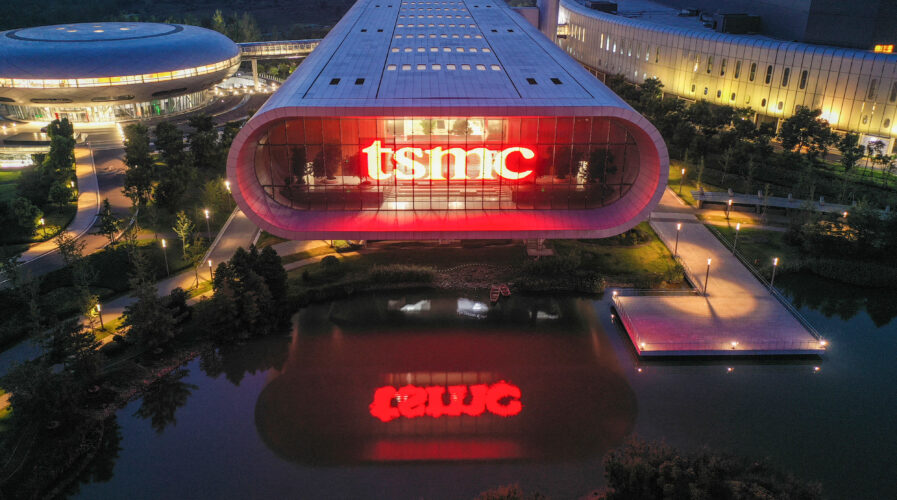
Companies won’t recover from chip shortages until 2024 or later — Bain & CompanyThis aerial photo taken on August 10, 2022 shows the view of a Taiwan Semiconductor Manufacturing Company (TSMC) factory in Nanjing, in China’s eastern Jiangsu province. (Photo by AFP) / China OUT
Companies won’t recover from chip shortages until 2024 or later — Bain & Company
- According to Bain’s analysis, while some companies are starting to see relief to the chip shortages this year, others may have to wait until 2024 or later before they start to recover.
- Recovery period is expected to be uneven and is dependent on several wild cards that are out of businesses’ control.
The global chip shortages have been dragging on for the past two years — with pundits predicting that we may just be approaching the end of it, sooner than later. Unfortunately, an abated chip shortage may not spell relief for all just yet. Even supply chains will take the time it requires to recover, let alone most business operations that are involved in the industry. Bain & Company however predicts that while some companies are starting to see relief this year, others may have to wait until 2024 or even later.
In Bain’s third annual global Technology Report, even with recent investments and signs of improvement, chip shortages recovery period is expected to be uneven and is dependent on several wild cards that are often out of executives control. The hindrance that could take place include things like chip demand pull-back, shortages of extreme ultraviolet (EUV) lithography equipment (a bottleneck machinery needed by chip makers) and the current status of geopolitical frictions.
“Many disruptive factors continue to dog semiconductor supply chains—acute events such as Covid-19 lockdowns and extreme weather that lead to short-term operational disruptions, as well as structural supply chain weaknesses that have caused shortages of “leading-edge” 12-inch wafers with transistors of 28 to 130 nanometers, “lagging-edge” 6- and 8-inch wafers, and advanced substrates for “bleeding-edge” chips with transistors of 5 to 14 nanometers,” the report reads.
Each, Bain reckon, has its own timeline to resolution. Precisely, according to a highlight of the report, automotive and industrial companies are starting to see relief from chip shortages, but advanced computing products remain in a challenging period. “Many have followed how automotive companies cut back orders when Covid-19 hit, only to find themselves at the back of the line for wafers when they later needed them,” Bain noted.
But the larger impact has come from skyrocketing demand for technology products, and the long lead times required to build the fabrication plants that supply their chips. That too has eventually led to a chip shortage that has often played out unevenly, affecting nearly every end market in some way, Bain said.
“These shortages will improve faster for certain products and industries, depending on the types of chips they use, but more tech executives are recognizing that the next phase of the shortage will be like the arcade game Whac-A-Mole,” the report noted. Basically what the report highlighted is how, as one shortage recedes, giving affected chip buyers all the computing components needed to produce a complete product, those buyers will start to consume chip supplies in another area, causing new shortages to pop up.

(Source – Shutterstock)
‘Wild cards’ that determines how the chip shortages plays out
Unfortunately, the fastest route to relief is softening demand — therefore a demand pullback is among the main wild cards. “Inconceivable for the past 2 ½ years, this now seems a distinct possibility, given the economic outlook. There are already reports of tech companies temporarily pausing new component orders and asking suppliers to delay or shrink shipments amid inflation worries and growing inventories,” Bain iterated.
The report by Bain also seems to emphasize on the impact of shortages involving extreme ultraviolet (EUV) lithography equipment. That is because those US$150-million-a-pop machines are needed to build bleeding-edge fabrication plants, and there’s only one supplier in the market which is ASML. “This bottleneck will likely grow over the next three years or so, potentially constraining capacity and limiting new plant openings at a time when semiconductor makers plan to spend well over US$150 billion on those new bleeding-edge production facilities,” it added.
Last and the most unavoidable wild card would be geopolitical frictions. This is considering how the semiconductor supply chain has become a major strategic asset in geopolitical maneuverings, and not just in China and the West. For context, this year, Russia limited exports of noble gasses, including neon, a crucial ingredient in chipmaking. That followed Japan’s 2019 restriction of exports to South Korea of high-purity hydrogen fluoride, an etching gas used in semiconductor manufacturing.
Then, “growing tensions between China and the US threaten to further bifurcate the global technology ecosystems,” Bain noted. Tit for tat actions also takes place since the US has already cut off China from receiving advanced tools, which was followed by domestic-first policies in China that might make it difficult for Western firms to access lagging-edge chips from China.
To wrap it up, the recovery will be choppy — and that is certained. Therefore Bain reckons companies to move quickly to control what they can, and invest in supply chain resilience so they’re ready for whatever comes next.
READ MORE
- Ethical AI: The renewed importance of safeguarding data and customer privacy in Generative AI applications
- How Japan balances AI-driven opportunities with cybersecurity needs
- Deploying SASE: Benchmarking your approach
- Insurance everywhere all at once: the digital transformation of the APAC insurance industry
- Google parent Alphabet eyes HubSpot: A potential acquisition shaping the future of CRM


